Spatiotemporal Prediction and Mapping of Heavy Metals at Regional Scale Using Regression Methods and Landsat 7
Abstract
:1. Introduction
2. Materials and Methods
2.1. Study Area and Topsoil Database
2.2. Satellite Data Acquisition and Processing
2.3. Data Preparation and Modelling
2.4. Geostatistical Prediction Method
3. Results
3.1. Soil Heavy Metal Contents
3.2. Comparison in Model Prediction Performance for 2009
3.3. Spatiotemporal Prediction Performance of RF
3.4. Spatiotemporal Distribution of Heavy Metals (HMs)
3.5. Comparison of Spatiotemporal Distribution Maps
4. Discussion
4.1. Soil Heavy Metal Contents
4.2. Comparison of Heavy Metals Prediction Performance of Models
4.3. Spatiotemporal Distribution of Heavy Metals and Comparison of Maps
5. Conclusions
Author Contributions
Funding
Institutional Review Board Statement
Informed Consent Statement
Data Availability Statement
Conflicts of Interest
Appendix A
| Sampling Points | Elevation (m asl *) |
|---|---|
| L-1 | 2.2 |
| L-2 | 12.7 |
| L-3 | 2.8 |
| L-4 | 4.2 |
| L-5 | 1.0 |
| L-6 | 4.3 |
| L-7 | −2.3 |
| L-8 | −1.0 |
| L-9 | 3.4 |
| L-10 | 1.8 |
| L-11 | 2.0 |
| L-12 | 1.8 |
| H-1 | 15.0 |
| H-2 | 23.9 |
| H-3 | 18.4 |
| H-4 | 29.3 |
| H-5 | 17.0 |
| H-6 | 30.4 |
| R-1 | 3.0 |
| R-2 | 0.0 |
| R-3 | 0.0 |
| R-4 | 3.9 |
| R-5 | 23.2 |
| R-6 | 13.8 |
| R-7 | 3.9 |
| R-8 | −0.6 |
| R-9 | 2.3 |
| R-10 | 7.2 |
| PLSR | RF | SVM | ||||||||||||
|---|---|---|---|---|---|---|---|---|---|---|---|---|---|---|
| HMs | LV | R2p | RMSEP (mg/kg) | RPD | RPIQ | R2p | RMSEP (mg/kg) | RPD | RPIQ | No. SV | R2p | RMSEP (mg/kg) | RPD | RPIQ |
| Sb | 7 | 0.41 | 0.02 | 1.30 | 1.00 | 0.81 | 0.009 | 2.33 | 1.80 | 242 | 0.67 | 0.012 | 1.74 | 1.34 |
| Pb | 4 | 0.49 | 2.22 | 1.40 | 1.72 | 0.92 | 0.897 | 3.47 | 4.27 | 222 | 0.79 | 1.425 | 2.19 | 2.69 |
| Ni | 4 | 0.41 | 2.37 | 1.31 | 1.27 | 0.75 | 1.549 | 2.01 | 1.95 | 268 | 0.56 | 2.055 | 1.51 | 1.47 |
| Mn | 6 | 0.22 | 38.15 | 1.13 | 1.17 | 0.73 | 22.572 | 1.92 | 1.97 | 260 | 0.47 | 31.345 | 1.38 | 1.42 |
| Hg | 5 | 0.54 | 0.01 | 1.47 | 1.49 | 0.87 | 0.003 | 2.82 | 2.85 | 248 | 0.74 | 0.005 | 1.99 | 2.01 |
| Cu | 4 | 0.19 | 1.82 | 1.12 | 0.93 | 0.76 | 0.991 | 2.05 | 1.70 | 244 | 0.49 | 1.440 | 1.41 | 1.17 |
| Cr | 2 | 0.06 | 3.20 | 1.04 | 0.74 | 0.62 | 2.038 | 1.63 | 1.17 | 256 | 0.48 | 2.101 | 1.39 | 1.13 |
| Co | 2 | 0.12 | 0.50 | 1.07 | 0.99 | 0.65 | 0.321 | 1.69 | 1.56 | 259 | 0.33 | 0.440 | 1.23 | 1.14 |
| Cd | 5 | 0.84 | 0.01 | 2.52 | 2.29 | 0.92 | 0.004 | 3.47 | 3.14 | 224 | 0.84 | 0.006 | 2.52 | 2.29 |
| As | 5 | 0.85 | 0.22 | 2.57 | 2.86 | 0.91 | 0.16 | 3.42 | 3.81 | 231 | 0.87 | 0.203 | 2.78 | 3.10 |
| HMs | 2009 | 2013 | 2016 | 2020 | ||||||||||||
|---|---|---|---|---|---|---|---|---|---|---|---|---|---|---|---|---|
| HMs | R2P | RMSEP (mg/kg) | RPDP | RPIQP | R2P | RMSEP (mg/kg) | RPDP | RPIQP | R2P | RMSEP (mg/kg) | RPDP | RPIQP | R2P | RMSEP (mg/kg) | RPDP | RPIQP |
| Sb | 0.81 | 0.009 | 2.33 | 1.80 | 0.82 | 0.01 | 2.38 | 1.84 | 0.83 | 0.01 | 2.46 | 1.89 | 0.82 | 0.01 | 2.37 | 1.83 |
| Pb | 0.92 | 0.897 | 3.47 | 4.27 | 0.91 | 0.96 | 3.26 | 4.00 | 0.91 | 0.95 | 3.29 | 4.05 | 0.90 | 0.97 | 3.20 | 1.93 |
| Ni | 0.75 | 1.549 | 2.01 | 1.95 | 0.73 | 1.61 | 1.93 | 1.87 | 0.74 | 1.58 | 1.97 | 1.90 | 0.72 | 1.65 | 1.89 | 1.83 |
| Mn | 0.73 | 22.572 | 1.92 | 1.97 | 0.69 | 24.04 | 1.80 | 1.85 | 0.66 | 24.94 | 1.73 | 1.78 | 0.65 | 25.62 | 1.69 | 1.74 |
| Hg | 0.87 | 0.003 | 2.82 | 2.85 | 0.85 | 0.00 | 2.59 | 2.62 | 0.85 | 0.00 | 2.62 | 2.66 | 0.84 | 0.00 | 2.53 | 2.56 |
| Cu | 0.76 | 0.991 | 2.05 | 1.70 | 0.73 | 1.06 | 1.92 | 1.59 | 0.70 | 1.10 | 1.84 | 1.53 | 0.69 | 1.13 | 1.79 | 1.49 |
| Cr | 0.62 | 2.038 | 1.63 | 1.17 | 0.53 | 2.26 | 1.47 | 1.05 | 0.57 | 2.17 | 1.53 | 1.09 | 0.54 | 2.24 | 1.48 | 1.06 |
| Co | 0.65 | 0.321 | 1.69 | 1.56 | 0.61 | 0.34 | 1.60 | 1.48 | 0.64 | 0.32 | 1.67 | 1.54 | 0.59 | 0.35 | 1.56 | 1.45 |
| Cd | 0.92 | 0.004 | 3.47 | 3.14 | 0.91 | 0.00 | 3.43 | 3.11 | 0.92 | 0.00 | 3.54 | 3.21 | 0.92 | 0.00 | 3.48 | 3.15 |
| As | 0.91 | 0.16 | 3.42 | 3.81 | 0.92 | 0.16 | 3.57 | 3.98 | 0.91 | 0.17 | 3.41 | 3.41 | 0.91 | 0.17 | 3.30 | 3.67 |
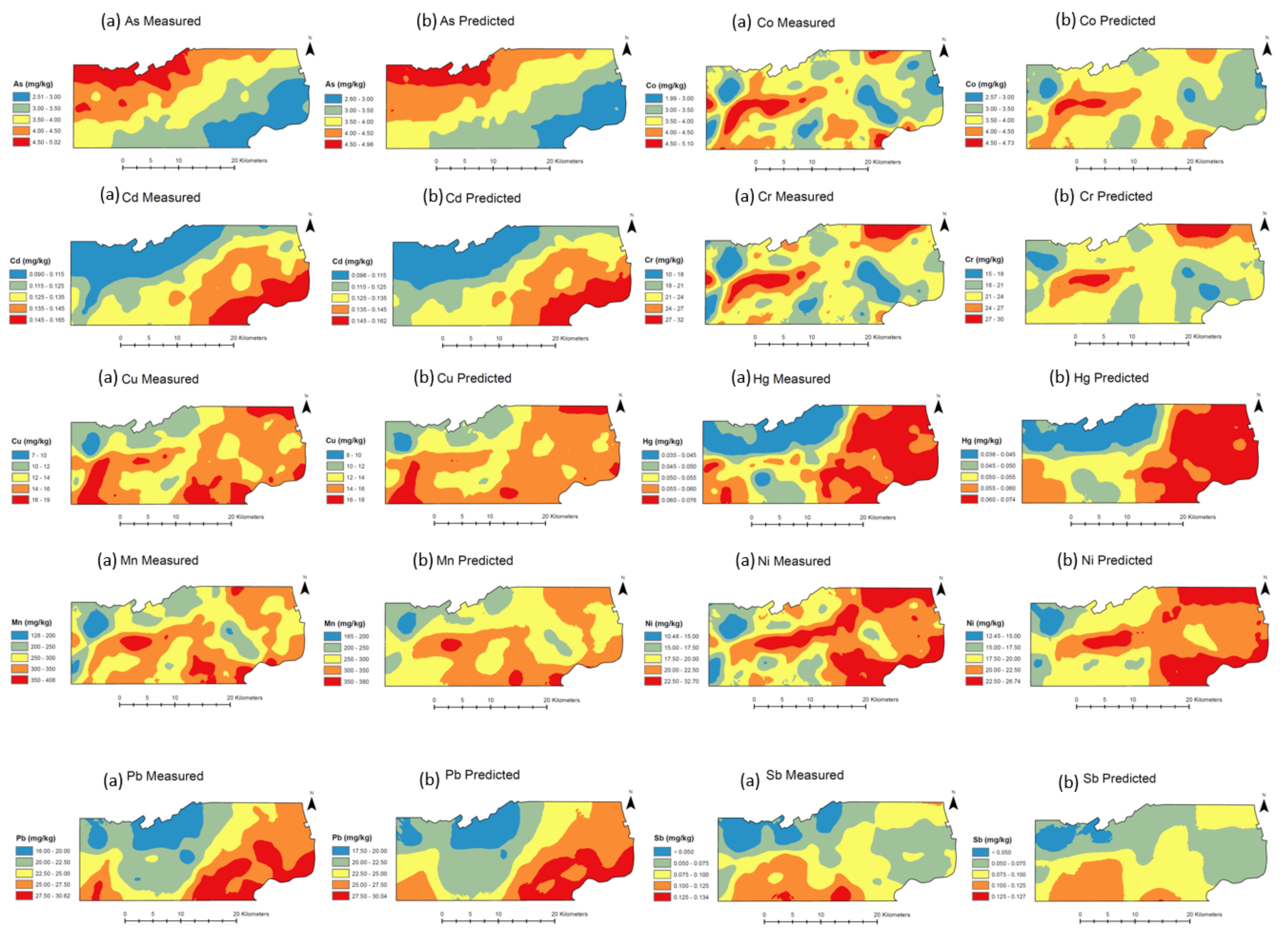
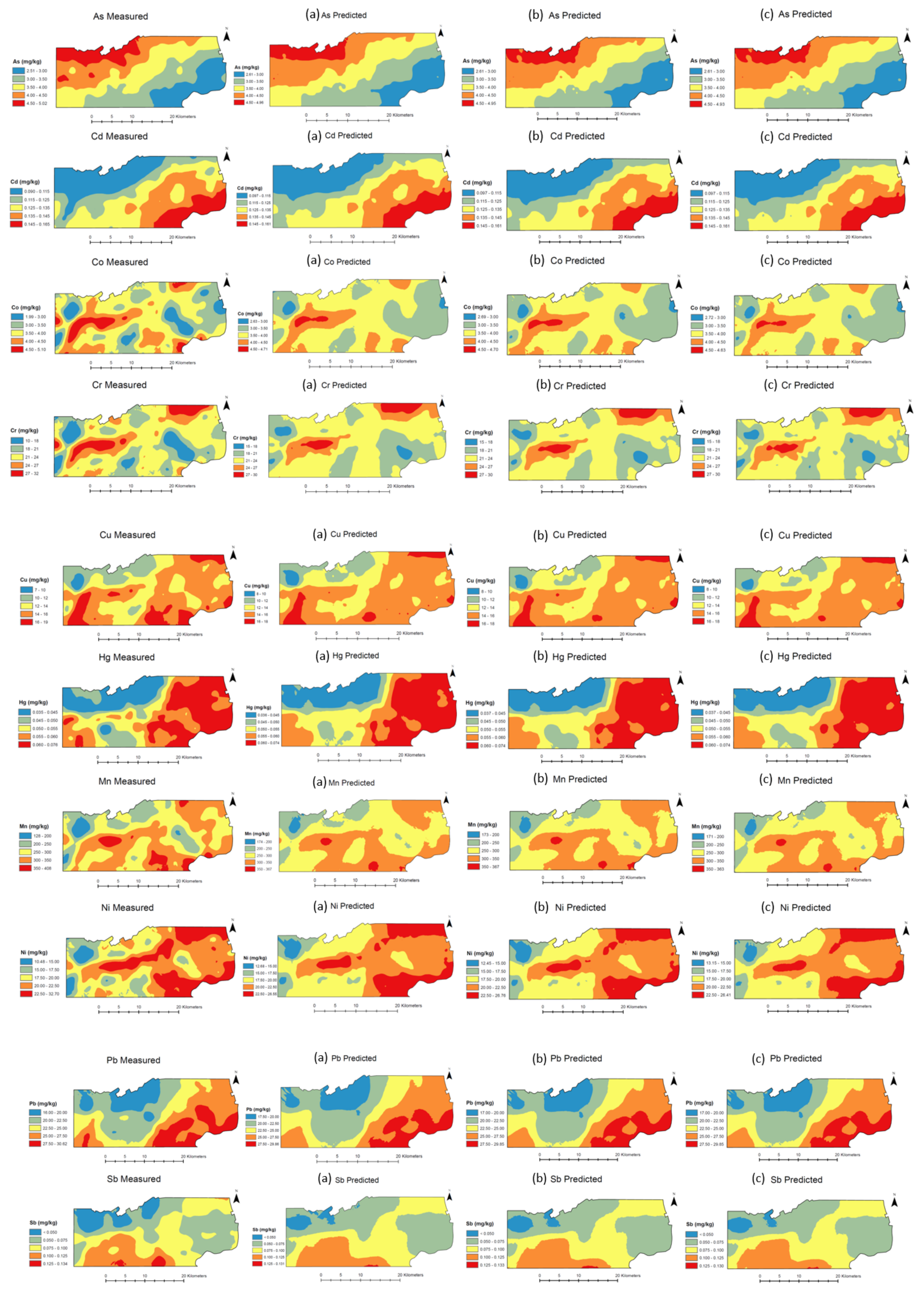
References
- Tóth, G.; Hermann, T.; Szatmári, G.; Pásztor, L. Maps of heavy metals in the soils of the European Union and proposed priority areas for detailed assessment. Sci. Total Environ. 2016, 565, 1054–1062. [Google Scholar] [CrossRef] [PubMed]
- Micó, C.; Peris, M.; Recatalá, L.; Sánchez, J. Baseline values for heavy metals in agricultural soils in an European Mediterranean region. Sci. Total Environ. 2007, 378, 13–17. [Google Scholar] [CrossRef]
- Hudcová, H.; Vymazal, J.; Rozkošný, M. Present restrictions of sewage sludge application in agriculture within the European Union. Soil Water Res. 2019, 14, 104–120. [Google Scholar] [CrossRef]
- Alengebawy, A.; Abdelkhalek, S.T.; Qureshi, S.R.; Wang, M.-Q. Heavy metals and pesticides toxicity in agricultural soil and plants: Ecological risks and human health implications. Toxics 2021, 9, 42. [Google Scholar] [CrossRef]
- Van Liedekerke, M.; Prokop, G.; Rabl-Berger, S.; Kibblewhite, M.; Louwagie, G. Progress in Management of Contaminated Sites in Europe; JRC Technical Reports; Publications Office of the European Union: Luxembourg, 2014. [Google Scholar]
- Lima, A.T.; Safar, Z.; Loch, J.P.G. Evaporation as the transport mechanism of metals in arid regions. Chemosphere 2014, 111, 638–647. [Google Scholar] [CrossRef]
- Liu, Y.; Li, W.; Wu, G.; Xu, X. Feasibility of estimating heavy metal contaminations in floodplain soils using laboratory-based hyperspectral data—A case study along Le’an River, China. Geo-Spatial Inf. Sci. 2011, 14, 10–16. [Google Scholar] [CrossRef] [Green Version]
- Slonecker, T.; Fisher, G.B.; Aiello, D.P.; Haack, B. Visible and infrared remote imaging of hazardous waste: A review. Remote Sens. 2010, 2, 2474–2508. [Google Scholar] [CrossRef] [Green Version]
- Von Steiger, B.; Webster, R.; Schulin, R.; Lehmann, R. Mapping heavy metals in polluted soil by disjunctive kriging. Environ. Pollut. 1996, 94, 205–215. [Google Scholar] [CrossRef]
- Kemper, T.; Sommer, S. Estimate of heavy metal contamination in soils after a mining accident using reflectance spectroscopy. Environ. Sci. Technol. 2002, 36, 2742–2747. [Google Scholar] [CrossRef]
- Ji, J.; Song, Y.; Yuan, X.; Yang, Z. Diffuse reflectance spectroscopy study of heavy metals in agricultural soils of the Changjiand River Delta, China. In Proceedings of the 19th World Congress of Soil Science, Soil Solutions for a Changing World, Brisbane, Australia, 1–6 August 2010; pp. 47–50. [Google Scholar]
- Fard, R.S.; Matinfar, H.R. Capability of vis-NIR spectroscopy and Landsat 8 spectral data to predict soil heavy metals in polluted agricultural land (Iran). Arab. J. Geosci. 2016, 9, 1–14. [Google Scholar]
- Fang, Y.; Xu, L.; Peng, J.; Wang, H.; Wong, A.; Clausi, D.A. Retrieval and mapping of heavy metal concentration in soil using time series landsat 8 imagery. Int. Arch. Photogramm. Remote Sens. Spat. Inf. Sci. ISPRS Arch. 2018, 42, 335–340. [Google Scholar] [CrossRef] [Green Version]
- Junliang, H.; Shuyuan, Z.; Yong, Z.; Jianjun, J. Review of retrieving soil heavy metal content by hyperspectral remote sensing. Remote Sens. Technol. Appl. 2015, 30, 407–412. [Google Scholar]
- Riedel, F.; Denk, M.; Müller, I.; Barth, N.; Gläßer, C. Prediction of soil parameters using the spectral range between 350 and 15,000 nm: A case study based on the Permanent Soil Monitoring Program in Saxony, Germany. Geoderma 2018, 315, 188–198. [Google Scholar] [CrossRef]
- Cheng, H.; Shen, R.; Chen, Y.; Wan, Q.; Shi, T.; Wang, J.; Wan, Y.; Hong, Y.; Li, X. Estimating heavy metal concentrations in suburban soils with reflectance spectroscopy. Geoderma 2019, 336, 59–67. [Google Scholar] [CrossRef]
- Al Maliki, A.; Owens, G.; Bruce, D. Capabilities of remote sensing hyperspectral images for the detection of lead contamination: A review. ISPRS Ann. Photogramm. Remote Sens. Spat. Inf. Sci. 2012, 1, 55–60. [Google Scholar] [CrossRef] [Green Version]
- Huang, X.; Senthilkumar, S.; Kravchenko, A.; Thelen, K.; Qi, J. Total carbon mapping in glacial till soils using near-infrared spectroscopy, Landsat imagery and topographical information. Geoderma 2007, 141, 34–42. [Google Scholar] [CrossRef]
- Zhou, T.; Geng, Y.; Ji, C.; Xu, X.; Wang, H.; Pan, J.; Bumberger, J.; Haase, D.; Lausch, A. Prediction of soil organic carbon and the C:N ratio on a national scale using machine learning and satellite data: A comparison between Sentinel-2, Sentinel-3 and Landsat-8 images. Sci. Total Environ. 2021, 755, 142661. [Google Scholar] [CrossRef] [PubMed]
- Ali, I.; Greifeneder, F.; Stamenkovic, J.; Neumann, M.; Notarnicola, C. Review of Machine Learning Approaches for Biomass and Soil Moisture Retrievals from Remote Sensing Data. Remote Sens. 2015, 7, 16398–16421. [Google Scholar] [CrossRef] [Green Version]
- Tóth, G.; Jones, A.; Montanarella, L. LUCAS Topsoil Survey: Methodology, Data, and Results; JRC Technical Reports; Publications Office: Luxembourg, 2013; ISBN 9789279325427. [Google Scholar]
- Viscarra Rossel, R.A.V.; Walvoort, D.J.J.; McBratney, A.B.; Janik, L.J.; Skjemstad, J.O. Visible, near infrared, mid infrared or combined diffuse reflectance spectroscopy for simultaneous assessment of various soil properties. Geoderma 2006, 131, 59–75. [Google Scholar] [CrossRef]
- Song, Y.; Ji, J.; Mao, C.; Ayoko, G.A.; Frost, R.L.; Yang, Z.; Yuan, X. The use of reflectance visible-NIR spectroscopy to predict seasonal change of trace metals in suspended solids of Changjiang River. Catena 2013, 109, 217–224. [Google Scholar] [CrossRef]
- Mouazen, A.M.; De Baerdemaeker, J.; Ramon, H. Effect of wavelength range on the measurement accuracy of some selected soil constituents using visual-near infrared spectroscopy. J. Near Infrared Spectrosc. 2006, 14, 189–199. [Google Scholar] [CrossRef]
- Martens, H.; Naes, T. Assessment, validation and choice of calibration method. In Multivariate Calibration; John Wiley & Sons: Hoboken, NJ, USA, 1989; pp. 237–266. [Google Scholar]
- Efron, B.; Tibshiran, R. (Eds.) An Introduction to the Bootstrap; Chapman &Hall, Inc.: London, UK, 1993. [Google Scholar]
- Vapnik, V.; Guyon, I.; Hastie, T. Support vector machines. Mach. Learn. 1995, 20, 273–297. [Google Scholar]
- Karatzoglou, A.; Feinerer, I. Kernel-based machine learning for fast text mining in R. Comput. Stat. Data Anal. 2010, 54, 290–297. [Google Scholar] [CrossRef]
- Meyer, D.; Wien, F.H.T. Support vector machines. In Interface Libsvm Package E1071; FH Technikum Wien: Vienna, Austria, 2015; pp. 1–28. [Google Scholar]
- Ho, T.K. The random subspace method for constructing decision forests. IEEE Trans. Pattern Anal. Mach. Intell. 1998, 20, 832–844. [Google Scholar]
- Breiman, L. Random forests. Mach. Learn. 2001, 45, 5–32. [Google Scholar] [CrossRef] [Green Version]
- Efron, B. Computers and the theory of statistics: Thinking the unthinkable. SIAM Rev. 1979, 21, 460–480. [Google Scholar] [CrossRef]
- R Foundation for Statistical Computing. R Core Team A Language and Environment for Statistical Computing; R Foundation for Statistical Computing: Vienna, Austria, 2020. [Google Scholar]
- Stevens, A.; Ramirez-Lopez, L. Package Vignette. In An Introduction to the Prospectr Package; R Package Version 0.2.0; University of Liege: Liege, Belgium, 2020; pp. 1–22. [Google Scholar]
- Wehrens, R. pls: Partial Least Squares Regression (PLSR) and Principal Component Regression (PCR). R Package Ver. 2.0-0. 2006. Available online: http//mevik.net/work/software/pls.html (accessed on 30 March 2021).
- Zaremba, L.S.; Smoleński, W.H. Optimal portfolio choice under a liability constraint. Ann. Oper. Res. 2000, 97, 131–141. [Google Scholar] [CrossRef]
- Garcia, H.; Filzmoser, P. Multivariate Statistical Analysis Using the R Package Chemometrics; Vienna University of Technology: Vienna, Austria, 2011; pp. 1–71. [Google Scholar]
- Farmer, W.H. Ordinary kriging as a tool to estimate historical daily streamflow records. Hydrol. Earth Syst. Sci. 2016, 20, 2721–2735. [Google Scholar] [CrossRef] [Green Version]
- Hu, B.; Chen, S.; Hu, J.; Xia, F.; Xu, J.; Li, Y.; Shi, Z. Application of portable XRF and VNIR sensors for rapid assessment of soil heavy metal pollution. PLoS ONE 2017, 12, e0172438. [Google Scholar] [CrossRef] [Green Version]
- Lv, J.; Liu, Y.; Zhang, Z.; Dai, J.; Dai, B.; Zhu, Y. Identifying the origins and spatial distributions of heavy metals in soils of Ju country (Eastern China) using multivariate and geostatistical approach. J. Soils Sediments 2015, 15, 163–178. [Google Scholar] [CrossRef]
- Ballabio, C.; Panagos, P.; Lugato, E.; Huang, J.-H.; Orgiazzi, A.; Jones, A.; Fernández-Ugalde, O.; Borrelli, P.; Montanarella, L. Copper distribution in European topsoils: An assessment based on LUCAS soil survey. Sci. Total Environ. 2018, 636, 282–298. [Google Scholar] [CrossRef] [PubMed]
- Ballabio, C.; Jiskra, M.; Osterwalder, S.; Borrelli, P.; Montanarella, L.; Panagos, P. A spatial assessment of mercury content in the European Union topsoil. Sci. Total Environ. 2021, 769, 144755. [Google Scholar] [CrossRef]
- De Temmerman, L.; Vanongeval, L.; Boon, W.; Hoenig, M.; Geypens, M. Heavy metal content of arable soils in Northern Belgium. Water Air Soil Pollut. 2003, 148, 61–76. [Google Scholar] [CrossRef]
- Cai, L.; Xu, Z.; Ren, M.; Guo, Q.; Hu, X.; Hu, G.; Wan, H.; Peng, P. Source identification of eight hazardous heavy metals in agricultural soils of Huizhou, Guangdong Province, China. Ecotoxicol. Environ. Saf. 2012, 78, 2–8. [Google Scholar] [CrossRef]
- Micó, C.; Recatalá, L.; Peris, M.; Sánchez, J. Assessing heavy metal sources in agricultural soils of an European Mediterranean area by multivariate analysis. Chemosphere 2006, 65, 863–872. [Google Scholar] [CrossRef] [PubMed]
- Alloway, B.J. Heavy Metals in Soils: Trace Metals and Metalloids in Soils and Their Bioavailability; Springer: Heidelberg, The Netherlands, 2012; Volume 22, ISBN 978-0-7514-0198-1. [Google Scholar]
- Martín, J.A.R.; Arias, M.L.; Corbí, J.M.G. Heavy metals contents in agricultural topsoils in the Ebro basin (Spain). Application of the multivariate geoestatistical methods to study spatial variations. Environ. Pollut. 2006, 144, 1001–1012. [Google Scholar] [CrossRef]
- Karatzoglou, A.; Meyer, D.; Hornik, K. Support vector algorithm in R. J. Stat. Softw. 2006, 15, 1–28. [Google Scholar] [CrossRef] [Green Version]
- Tan, K.; Ma, W.; Wu, F.; Du, Q. Random forest–based estimation of heavy metal concentration in agricultural soils with hyperspectral sensor data. Environ. Monit. Assess. 2019, 191, 446. [Google Scholar] [CrossRef]
- Wold, S. Personal memories of the early PLS development. Chemom. Intell. Lab. Syst. 2001, 58, 83–84. [Google Scholar] [CrossRef]
- Gholizadeh, A.; Borůvka, L.; Saberioon, M.M.; Kozak, J.; Vašát, R.; Němeček, K. Comparing different data preprocessing methods for monitoring soil heavy metals based on soil spectral features. Soil Water Res. 2015, 10, 218–227. [Google Scholar] [CrossRef] [Green Version]
- Wenjun, J.; Zhou, S.; Jingyi, H.; Shuo, L. In situ measurement of some soil properties in paddy soil using visible and near-infrared spectroscopy. PLoS ONE 2014, 9, e105708. [Google Scholar]
- Fu, P.; Weng, Q. A time series analysis of urbanization induced land use and land cover change and its impact on land surface temperature with Landsat imagery. Remote Sens. Environ. 2016, 175, 205–214. [Google Scholar] [CrossRef]
- Devai, I.; Patrick, W.H., Jr.; Neue, H.; De Laune, R.D.; Kongchum, M.; Rinklebe, J. Methyl mercury and heavy metal content in soils of rivers Saale and Elbe (Germany). Anal. Lett. 2005, 38, 1037–1048. [Google Scholar] [CrossRef]
- Six, L.; Smolders, E. Future trends in soil cadmium concentration under current cadmium fluxes to European agricultural soils. Sci. Total Environ. 2014, 485–486, 319–328. [Google Scholar] [CrossRef]
- Travnikov, O.; Ilyin, I.; Rozovskaya, O.; Varygina, M.; Aas, W.; Uggerud, H.T.; Mareckova, K.; Wankmueller, R. Long-term changes of heavy metal transboundary pollution of the environment (1990–2010). EMEP Status Rep. 2012, 2, 1–63. [Google Scholar]
- Gentile, A.R.; Barceló-Cordón, S.; Van Liedekerke, M. Soil Country Analyses-Belgium; JRC: Ispra, Italy, 2009; ISBN 9789279133510. [Google Scholar]
- Kashefipour, S.M.; Roshanfekr, A. Numerical modelling of heavy metals transport processes in riverine basins. Numer. Model. 2012, 6, 66–69. [Google Scholar]
- Yan, H.; Zhang, H.; Shi, Y.; Ping, Z.; Huan, L.I.; Wu, D.; Liu, L.I.U. Simulation on release of heavy metals Cd and Pb in sediments. Trans. Nonferrous Met. Soc. China 2021, 31, 277–287. [Google Scholar] [CrossRef]
- Förstner, U.; Müller, G. Heavy metal accumulation in river sediments: A response to environmental pollution. Geoforum 1973, 4, 53–61. [Google Scholar] [CrossRef]
- Yi, Z.; Liu, M.; Liu, X.; Wang, Y.; Wu, L.; Wang, Z.; Zhu, L. Long-term Landsat monitoring of mining subsidence based on spatiotemporal variations in soil moisture: A case study of Shanxi Province, China. Int. J. Appl. Earth Observ. Geoinf. 2021, 102, 102447. [Google Scholar] [CrossRef]
- Qaswar, M.; Yiren, L.; Jing, H.; Kaillou, L.; Mudasir, M.; Zhenzhen, L.; Hongqian, H.; Xianjin, L.; Jianhua, J.; Ahmed, W.; et al. Soil nutrients and heavy metal availability under long-term combined application of swine manure and synthetic fertilizers in acidic paddy soil. J. Soils Sediments 2020, 20, 2093–2106. [Google Scholar] [CrossRef]
- Zhang, Y.; Zhang, X.; Bi, Z.; Yu, Y.; Shi, P.; Ren, L.; Shan, Z. The impact of land use changes and erosion process on heavy metal distribution in the hilly area of the Loess Plateau, China. Sci. Total Environ. 2020, 718, 137305. [Google Scholar] [CrossRef] [PubMed]
- Xiao, W.; Lin, G.; He, X.; Yang, Z.; Wang, L. Interactions among heavy metal bioaccessibility, soil properties and microbial community in phyto-remediated soils nearby an abandoned realgar mine. Chemosphere 2022, 286, 131638. [Google Scholar] [CrossRef] [PubMed]
- Mohamed, E.S.; Baroudy, A.; El-beshbeshy, T.; Emam, M.; Belal, A.A.; Elfadaly, A.; Aldosari, A.A.; Ali, A.; Lasaponara, R. Vis-NIR Spectroscopy and Satellite Landsat-8 OLI Data to Map Soil Nutrients in Arid Conditions: A Case Study of the Northwest Coast of Egypt. Remote Sens. 2020, 12, 3716. [Google Scholar] [CrossRef]
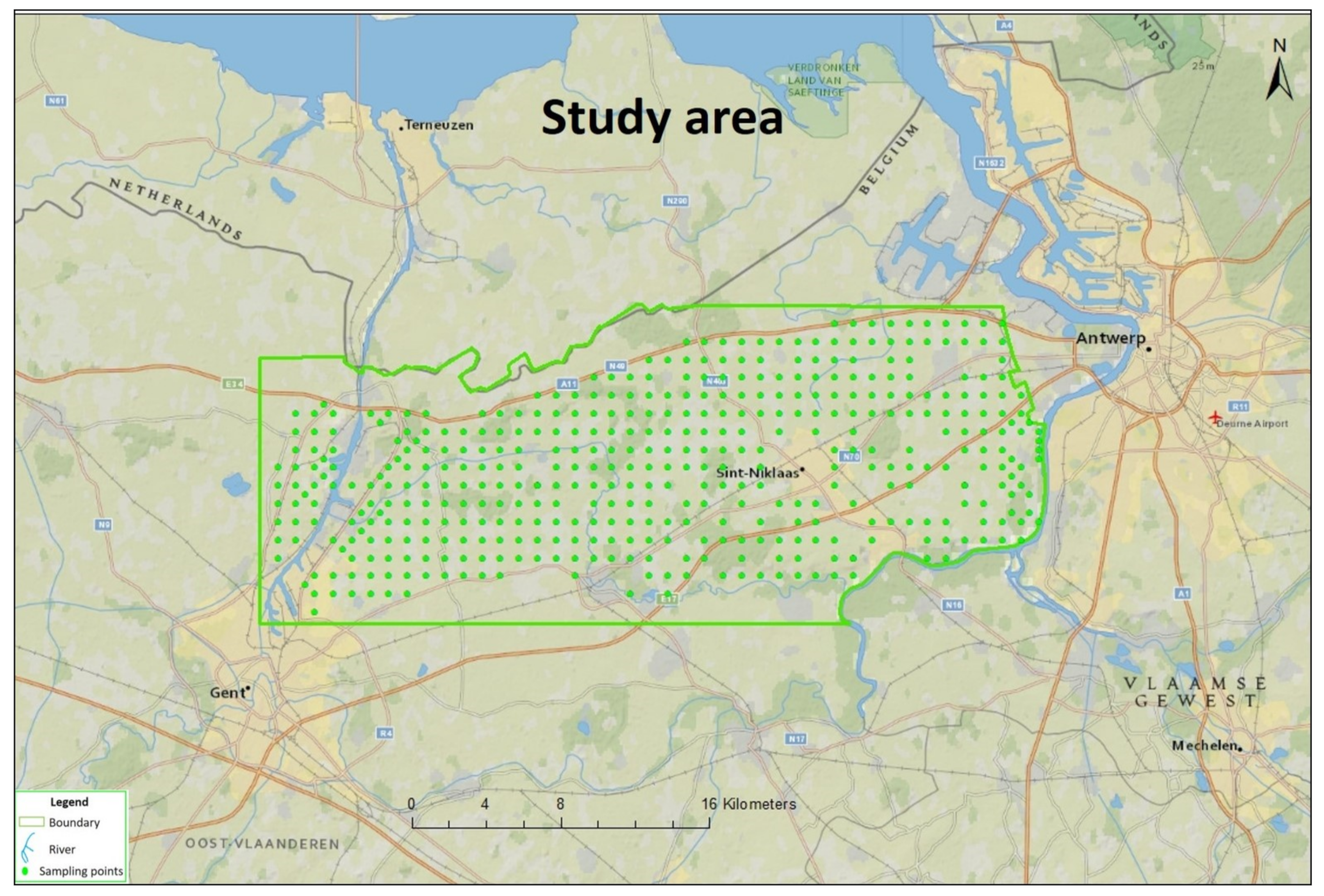
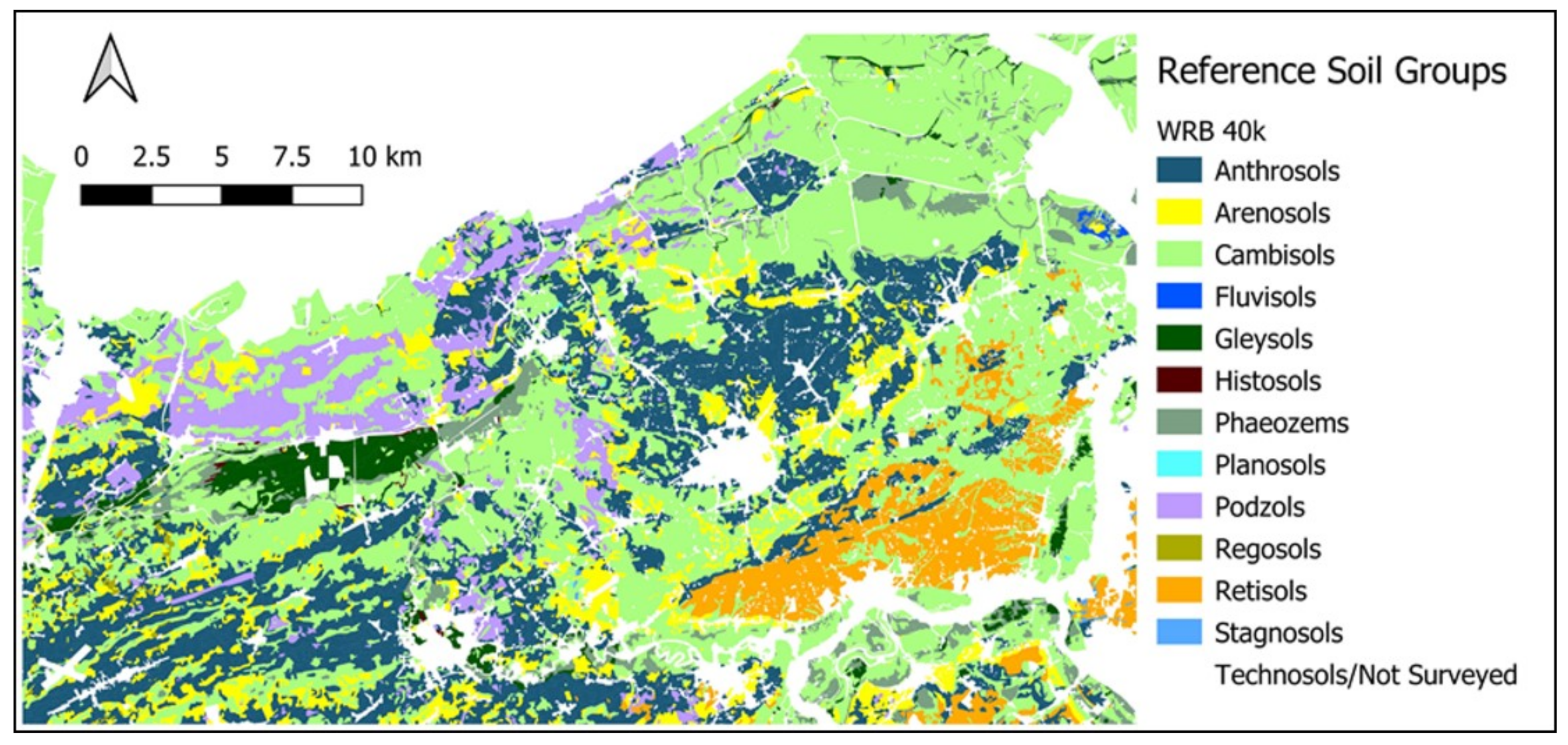
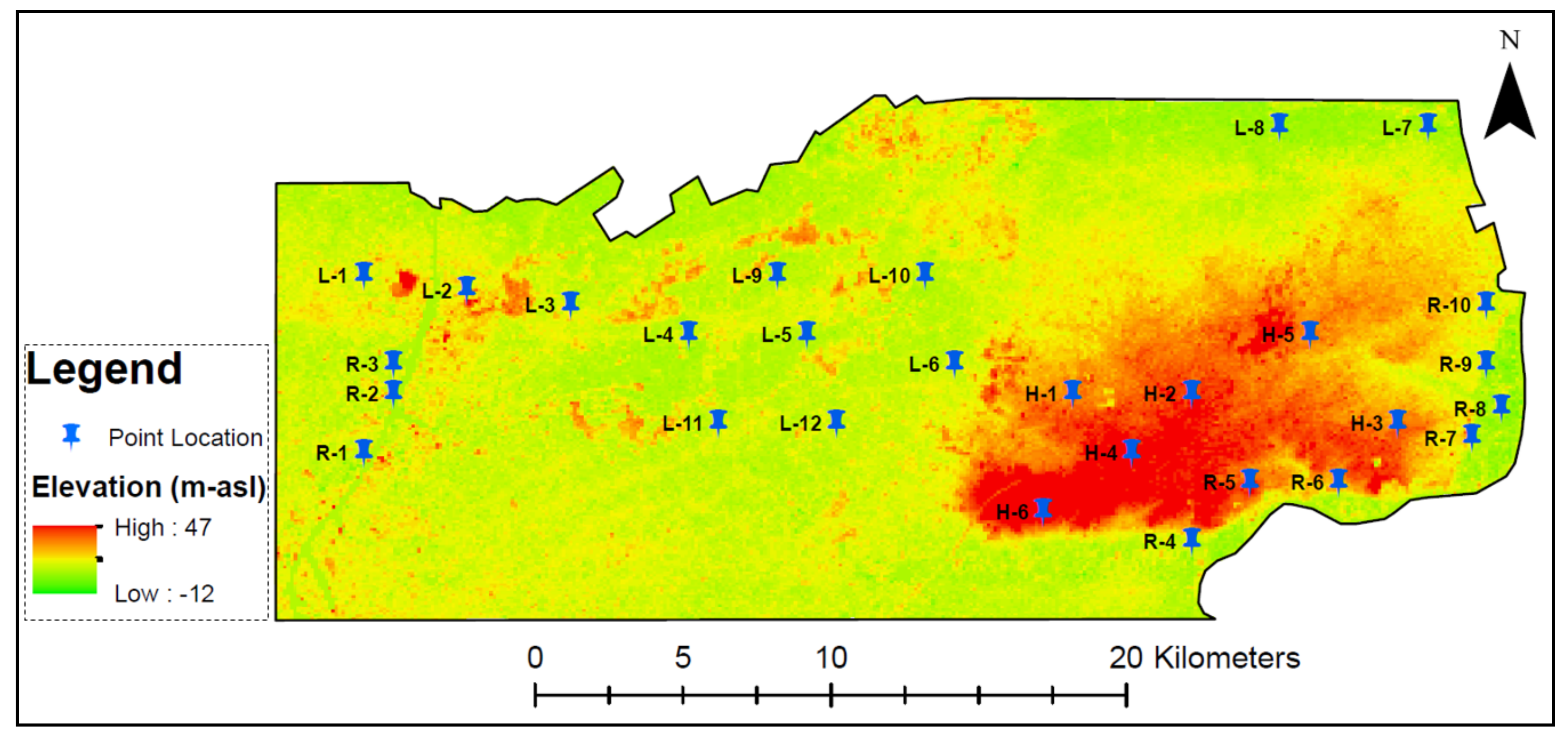
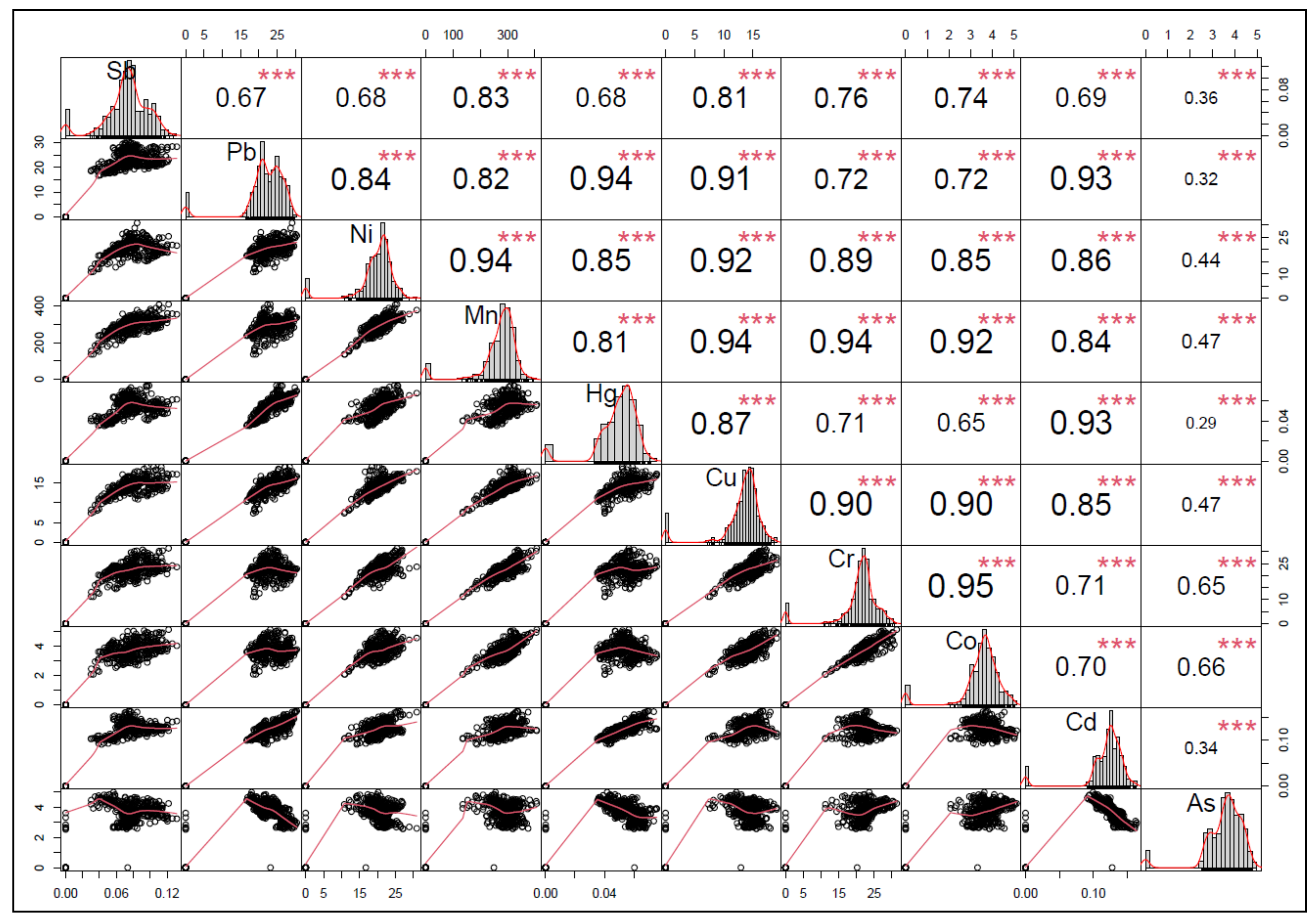
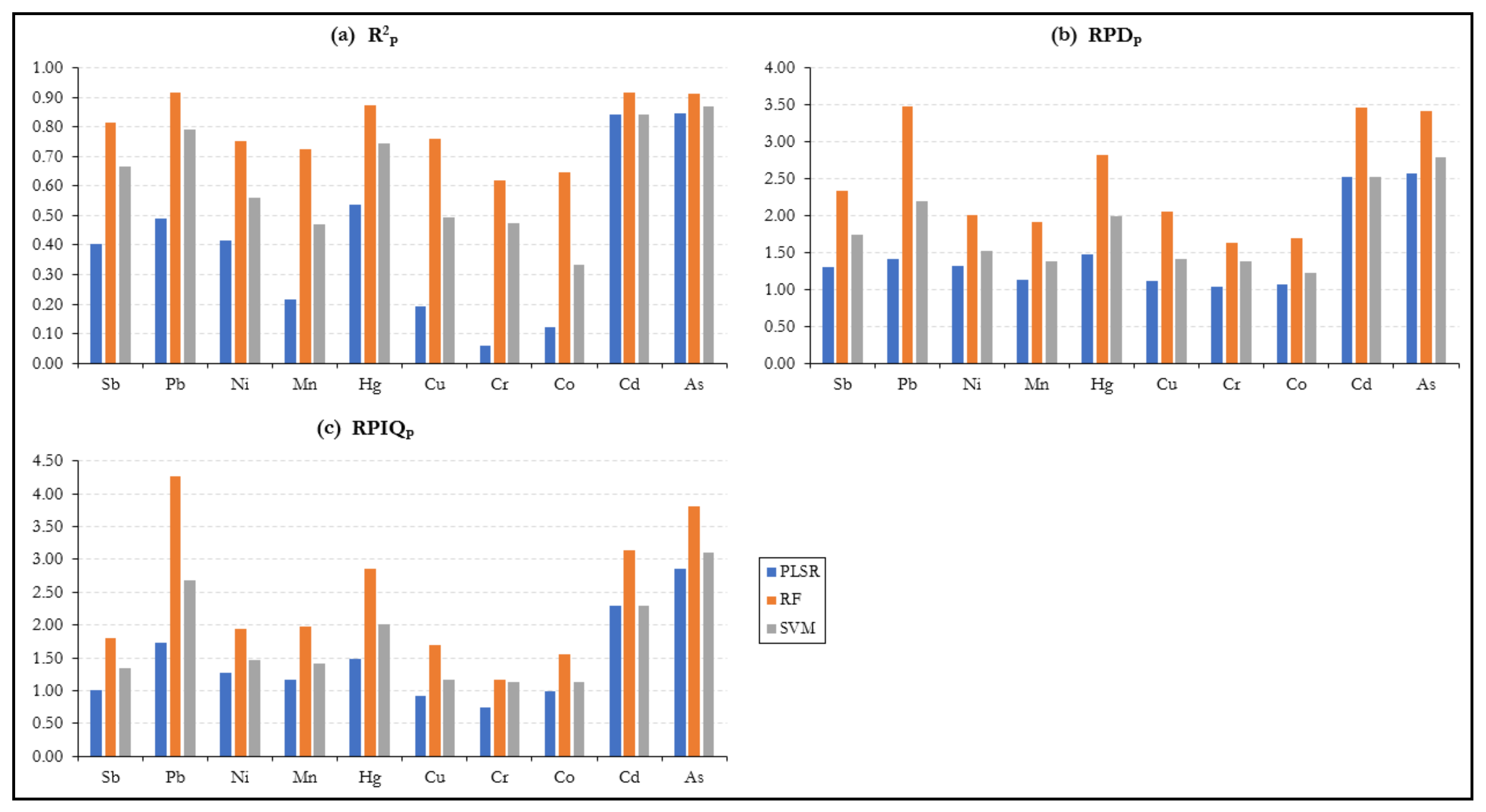
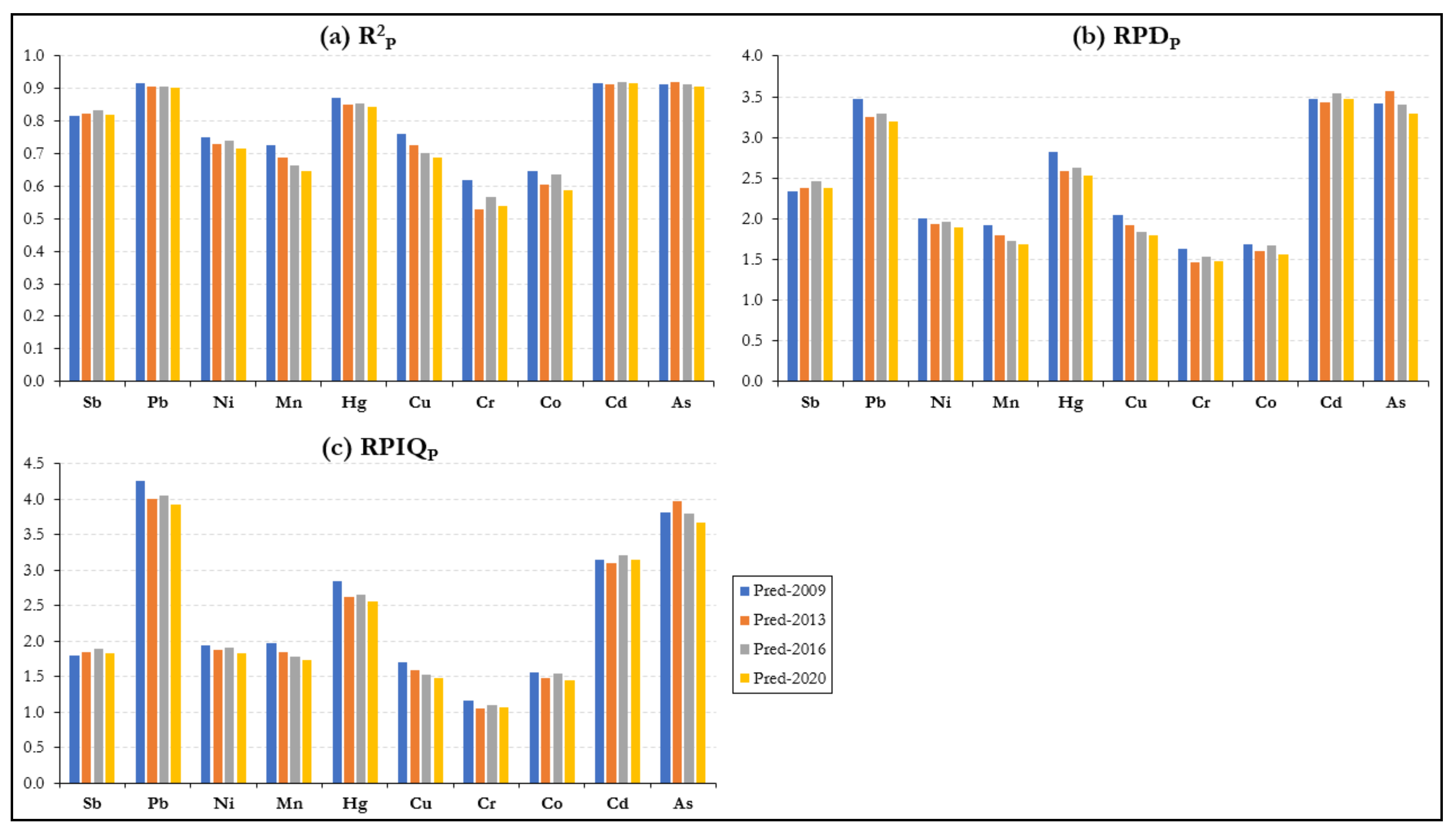
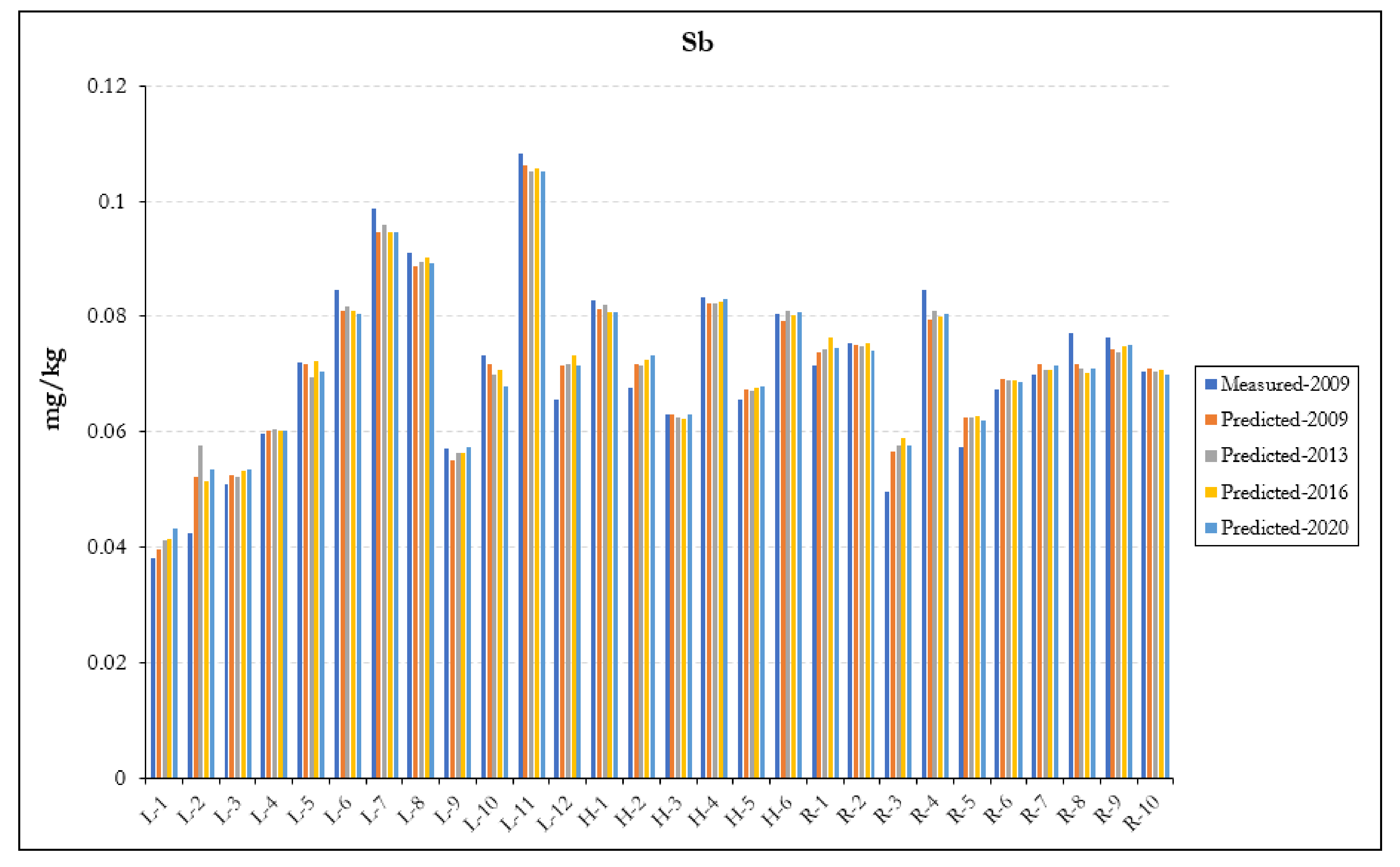
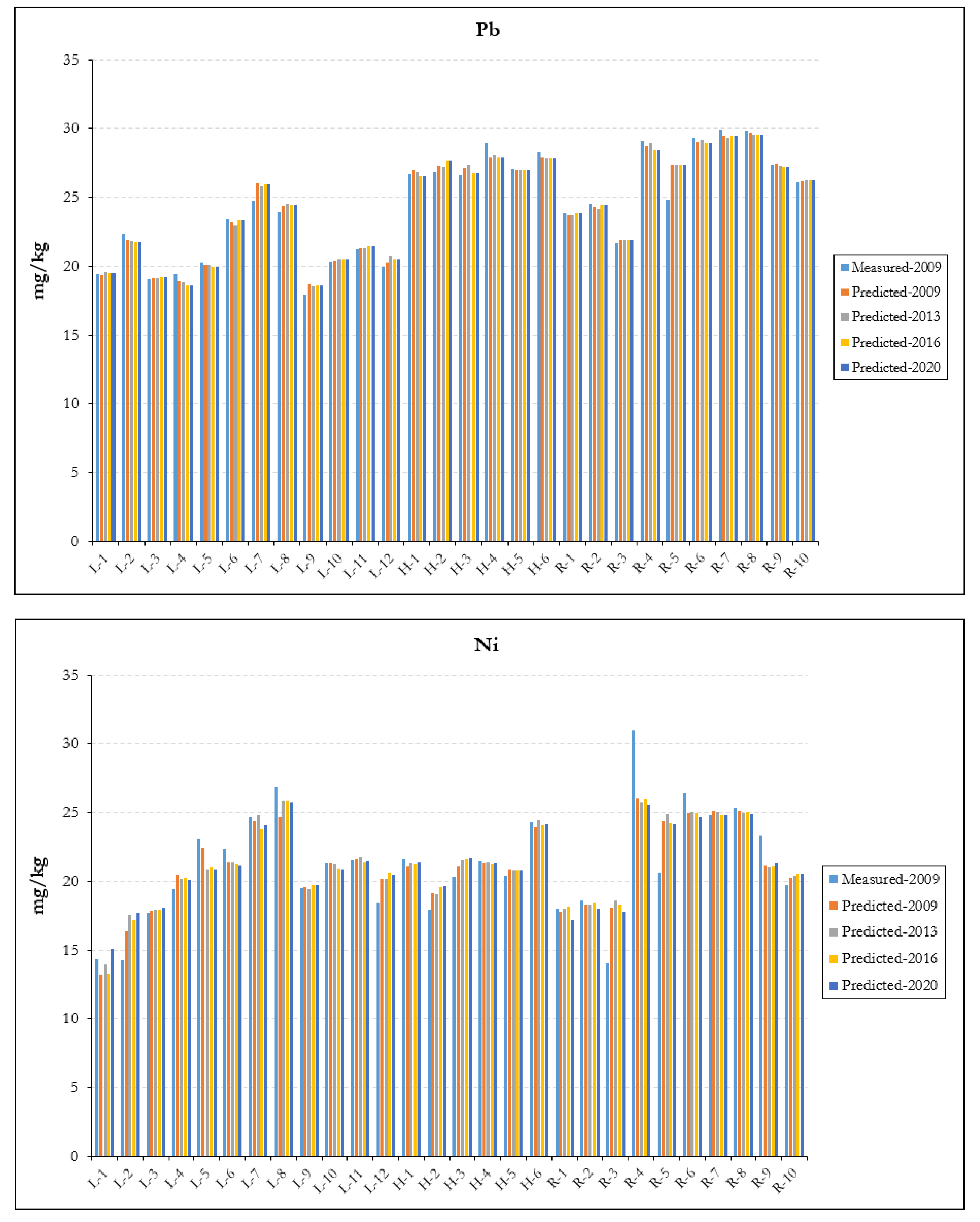

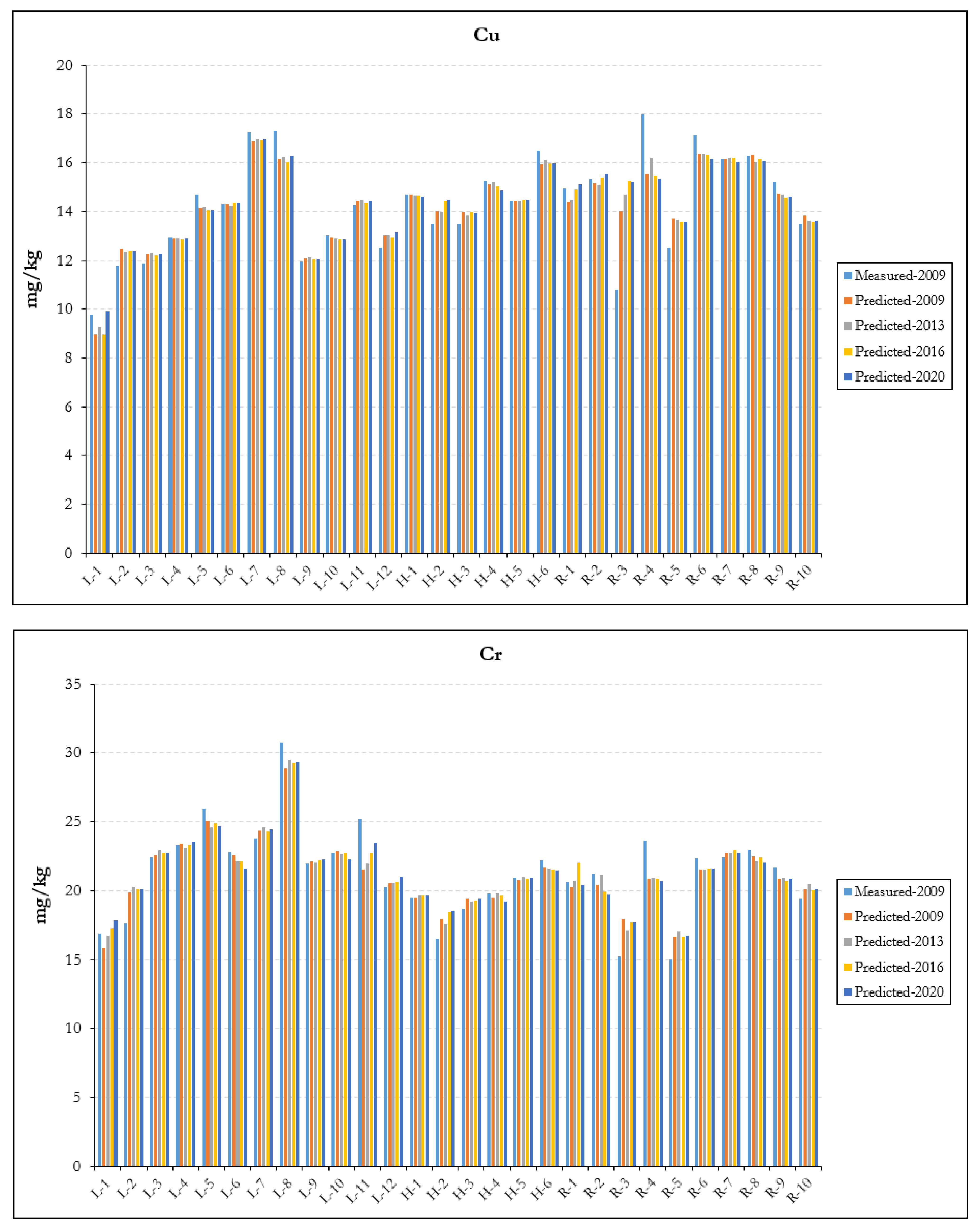
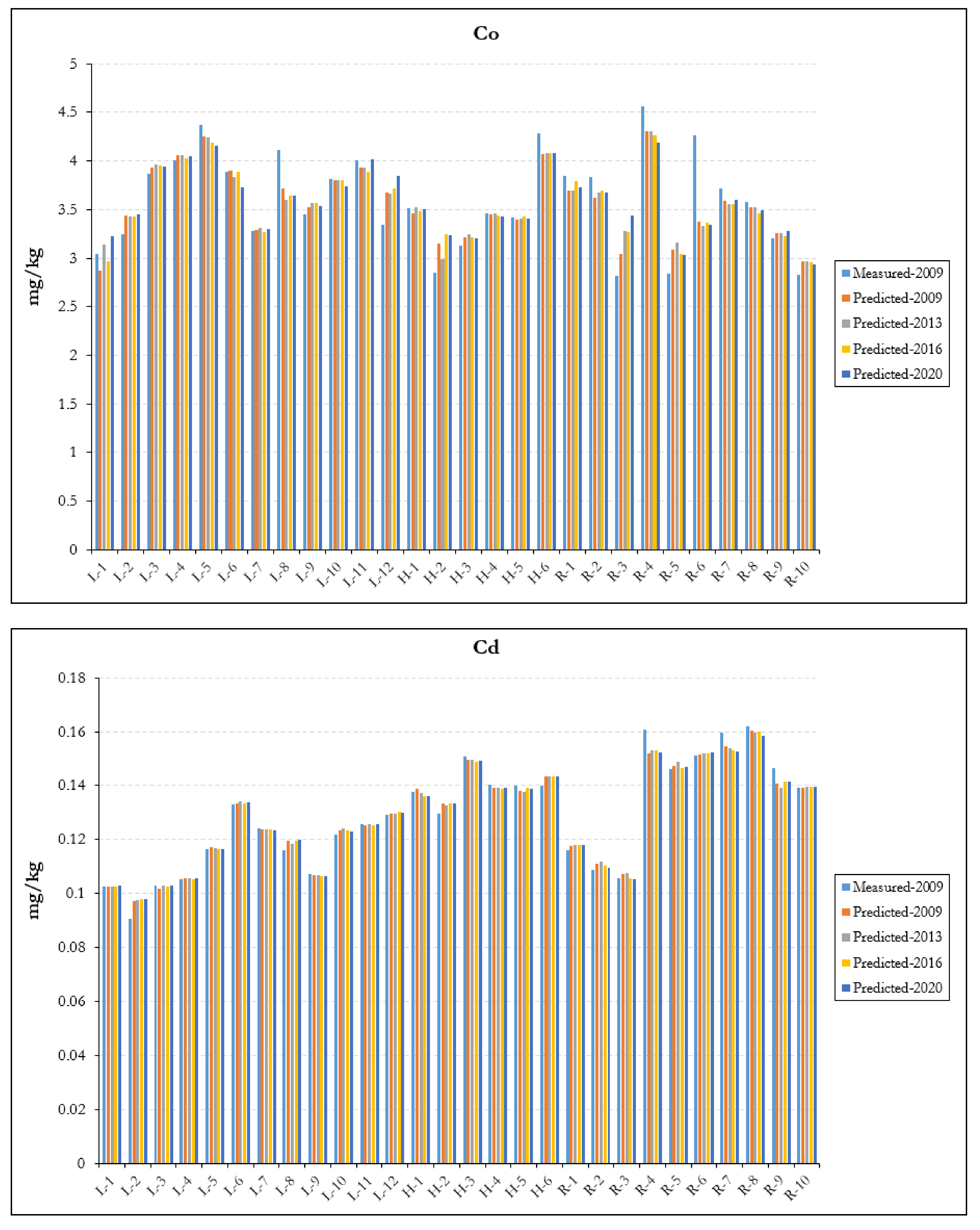
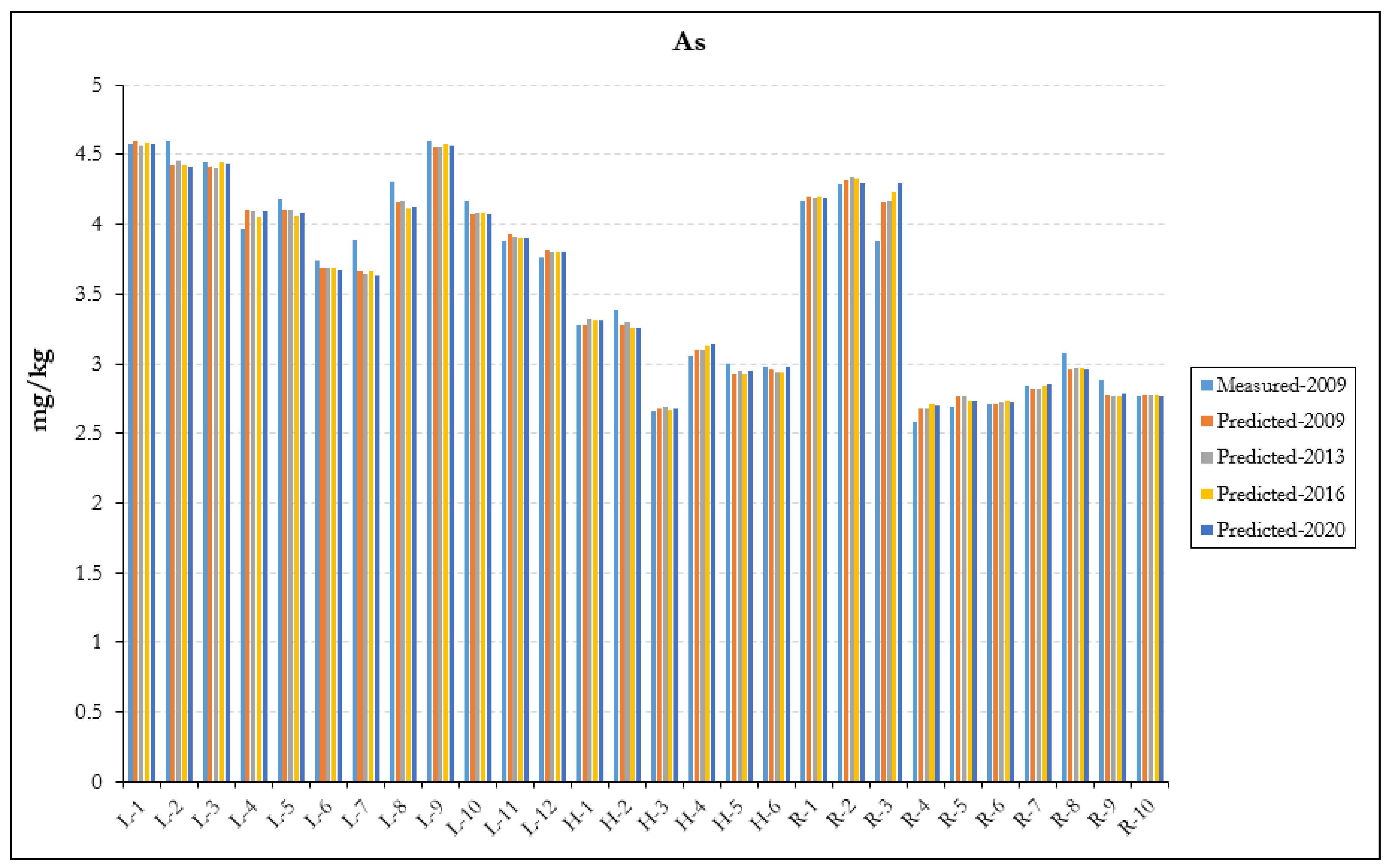
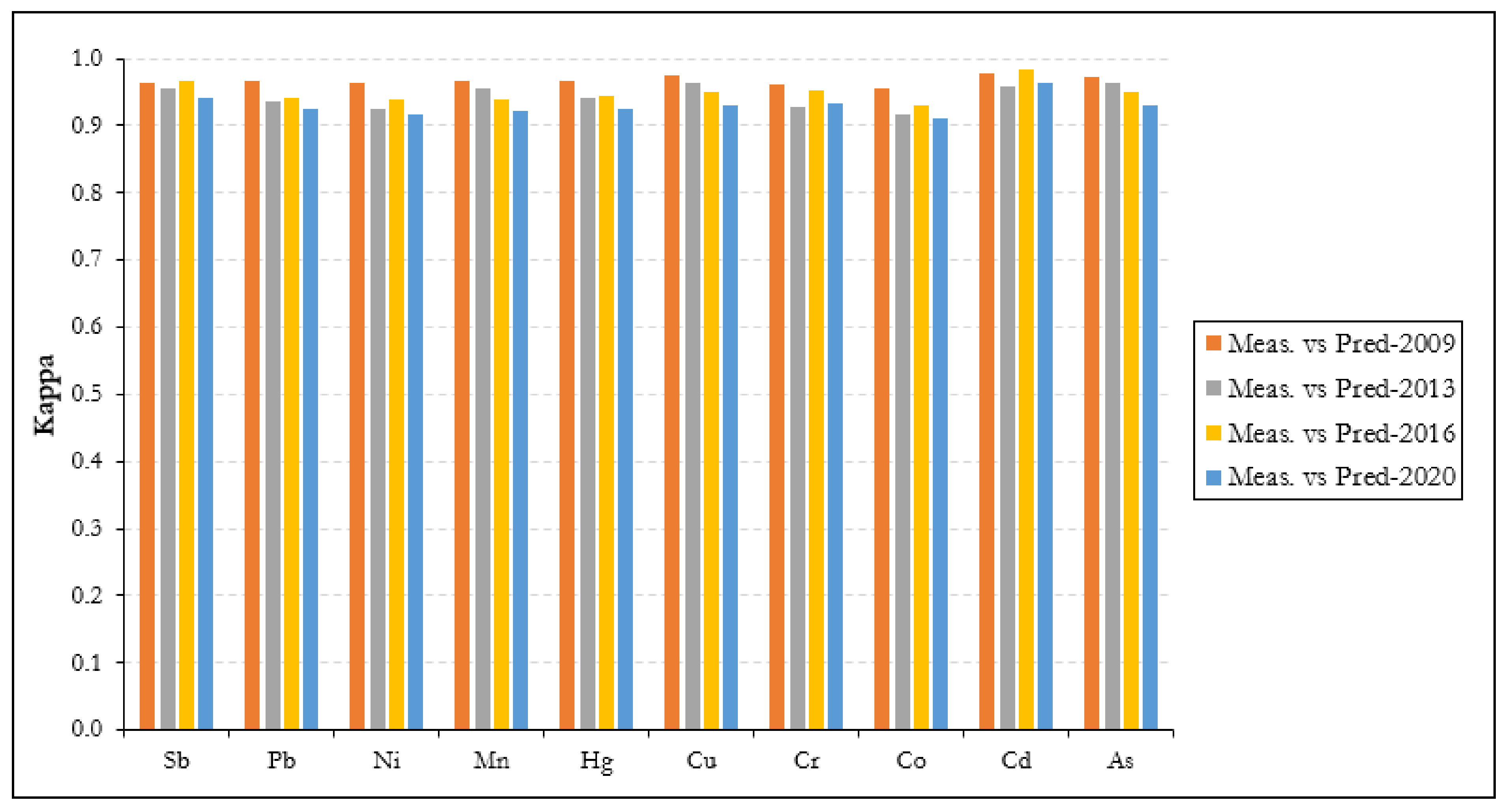
| Heavy Metals (mg/kg) | Min | 1st Qu * | Median | Mean ± SD ** | 3rd Qu | Max | Kurtosis |
|---|---|---|---|---|---|---|---|
| Sb | 0 | 0.066 | 0.076 | 0.075 ± 0.025 | 0.090 | 0.131 | 1.80 |
| Pb | 0 | 20.89 | 23.01 | 22.44 ± 5.81 | 25.87 | 30.34 | 7.47 |
| Ni | 0 | 18.55 | 20.96 | 19.78 ± 5.22 | 22.54 | 30.93 | 6.87 |
| Mn | 0 | 262.00 | 295.10 | 278.60 ± 73.34 | 318.70 | 407.10 | 6.97 |
| Hg | 0 | 0.048 | 0.055 | 0.052 ± 0.014 | 0.061 | 0.076 | 5.36 |
| Cu | 0 | 12.95 | 14.34 | 13.57 ± 3.50 | 15.35 | 19.08 | 7.74 |
| Cr | 0 | 20.43 | 22.37 | 21.47 ± 5.66 | 23.91 | 31.38 | 6.94 |
| Co | 0 | 3.34 | 3.72 | 3.56 ± 0.94 | 4.03 | 5.13 | 7.00 |
| Cd | 0 | 0.114 | 0.126 | 0.120 ± 0.030 | 0.136 | 0.164 | 9.32 |
| As | 0 | 3.27 | 3.72 | 3.58 ± 0.86 | 4.12 | 4.98 | 7.32 |
Publisher’s Note: MDPI stays neutral with regard to jurisdictional claims in published maps and institutional affiliations. |
© 2021 by the authors. Licensee MDPI, Basel, Switzerland. This article is an open access article distributed under the terms and conditions of the Creative Commons Attribution (CC BY) license (https://creativecommons.org/licenses/by/4.0/).
Share and Cite
Mouazen, A.M.; Nyarko, F.; Qaswar, M.; Tóth, G.; Gobin, A.; Moshou, D. Spatiotemporal Prediction and Mapping of Heavy Metals at Regional Scale Using Regression Methods and Landsat 7. Remote Sens. 2021, 13, 4615. https://doi.org/10.3390/rs13224615
Mouazen AM, Nyarko F, Qaswar M, Tóth G, Gobin A, Moshou D. Spatiotemporal Prediction and Mapping of Heavy Metals at Regional Scale Using Regression Methods and Landsat 7. Remote Sensing. 2021; 13(22):4615. https://doi.org/10.3390/rs13224615
Chicago/Turabian StyleMouazen, Abdul M., Felix Nyarko, Muhammad Qaswar, Gergely Tóth, Anne Gobin, and Dimitrios Moshou. 2021. "Spatiotemporal Prediction and Mapping of Heavy Metals at Regional Scale Using Regression Methods and Landsat 7" Remote Sensing 13, no. 22: 4615. https://doi.org/10.3390/rs13224615
APA StyleMouazen, A. M., Nyarko, F., Qaswar, M., Tóth, G., Gobin, A., & Moshou, D. (2021). Spatiotemporal Prediction and Mapping of Heavy Metals at Regional Scale Using Regression Methods and Landsat 7. Remote Sensing, 13(22), 4615. https://doi.org/10.3390/rs13224615











